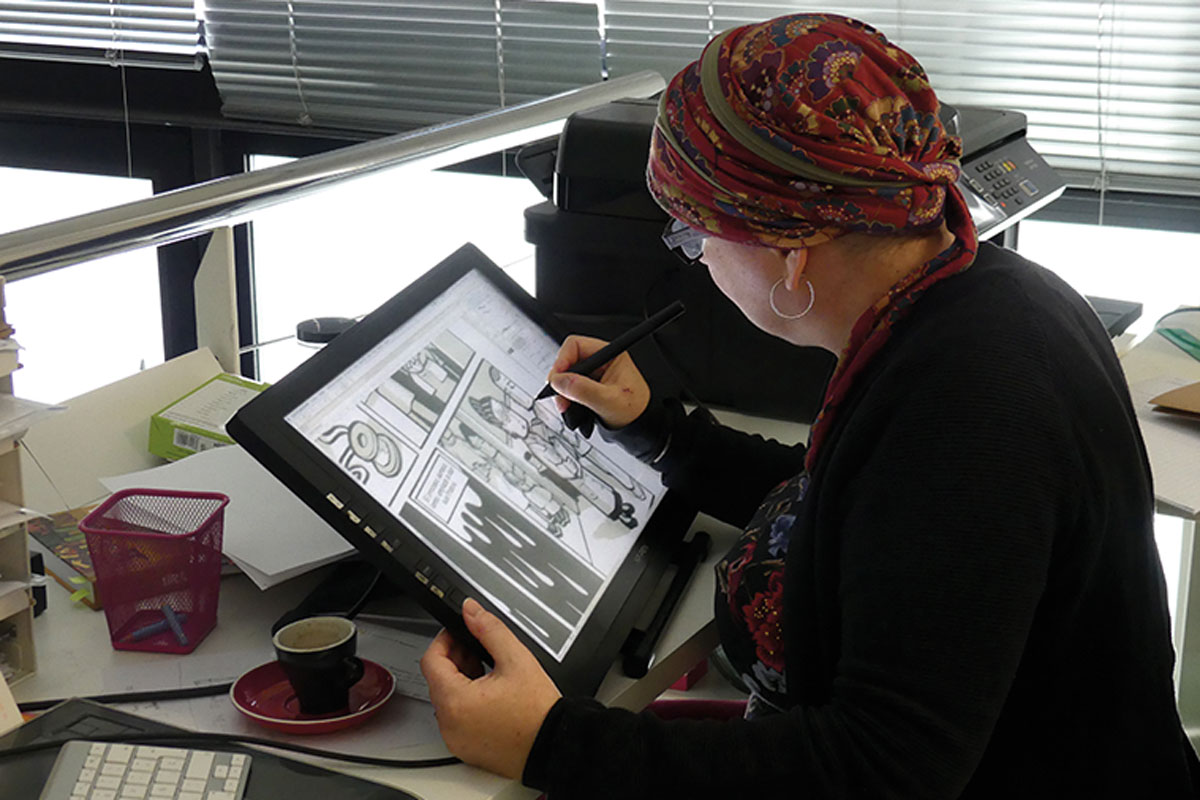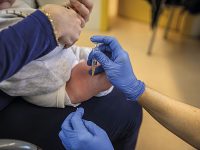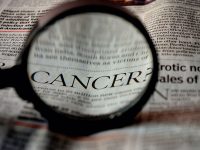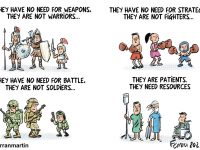
On 12 November 2019, Cristina went into surgery to have a centimetre-sized tumour that had been detected in her right breast on 8 October of that year removed. «As soon as I came out of the operating room, I found out that I had won the National Comic Prize for the graphic novel El día 3», says the Valencian illustrator Cristina Durán as she gingerly adjusts the scarf she wears on her head.
Two months later, when the doctors told her that she had to undergo chemotherapy, she knew that the process would take longer. So she decided to go public on social media. On 4 February 2020, on the occasion of World Cancer Day, Durán published a cartoon on Twitter in which she summarised her experience with the disease. Thousands of personalities from the world of culture expressed their support.

The illustrator Cristina Duran drew a cartoon to announce through social networks that she had breast cancer / Photo: Ferran Antequera Beltran. Illustration: Cristina Duran
Cristina, together with her partner, Miguel Ángel Giner – the scriptwriter of most of her works – has published autobiographical comics about parenthood: Una posibilidad entre mil (2009), where they narrate the birth and diagnosis of cerebral palsy of their daughter Laia, and La máquina de Efrén (2012), about the adoption process of Selam, originally from Ethiopia. In addition, according to Durán, she expects to publish a comic about her own experience with cancer, a disease that, in 2019, claimed the lives of 110,367 people in Spain, according to data collected by the Spanish Association Against Cancer (AECC).
For Álvaro Pons, professor of Optics at the University of Valencia and director of the Chair of Comic Studies of the SM-UV Foundation, comics have always been a reflection of the social reality of each era. And, therefore, cancer has always been present in comics, since «this is the disease that scares us humans the most», according to Prof. Pons. Although cardiovascular diseases are the leading cause of death in the world and in Spain, Pons is not wrong when he says that cancer is still one of the diseases that causes the most deaths and fears in today’s society.
«Comics have always been a reflection of social reality and cancer is still one of the diseases that causes the most deaths and fears in today’s society»
Comics were born around the 1830s. Since then, cartoonists and comic book authors, who were not considered «real artists» until the 1980s, have reflected in their works the reality they had to live from the artistic marginality: «They were common people who reflected about everything that was happening», Pons continues. «That is to say, they have never been part of any intellectual circle and this allowed them to be more in touch with the social reality of the time». This exceptional condition means that comics have become an art form that is faithful to the social reality of each period. Cancer, unfortunately, is also a reality, and it is unquestionably around us.
Pons talks about The death of captain Marvel (1982), a superhero comic book in which the main character dies of cancer. For him, it is the first comic book to deal with this subject: «For the first time, a superhero cannot defeat a threat from the real world, cancer; a threat that ends up killing the hero, and that can also kill normal people who have no powers». This Marvel comic, like many others that would follow, can be considered graphic medicine.

Our cancer year (1994), a graphic novel in which the American author Harvey Pekar, together with Joyce Brabner and Frank Stack, narrated his experience with cancer. The work is a bitter portrait that reflects the social perception of an ailment that, at the time, still had little therapeutic options. / Da capo Press Inc.
Graphic medicine is a term coined in 2007 by British physicist, cartoonist, and physician Ian Williams, who described it as «the intersection between the medium of comics and the discourse of healthcare». As Mónica Lalanda, doctor and Spanish coordinator of the Graphic Medicine movement, says, when creating a comic, authors do not seek any other objective than to tell a story: «in most cases, their own story». This is also because, as Pons points out, «their main function is not social, but cathartic».
The death of Captain Marvel has no biographical details. It is, therefore, a rarity in graphic medicine. And this is because the title was published at a time of change for comics, when cartoonists began to perceive their own work as art, which would lead to the cultural elite’s acceptance of the concept of the graphic novel.
In this context, in the mid-1990s, an American author called Harvey Pekar was the first person to narrate his own personal experience with cancer through comics. This work, scripted by Pekar himself and Joyce Brabner, and illustrated by Frank Stack, is titled Our cancer year (1994), a bitter and crude portrait of cancer that reflects the social perception of a disease that, at that time, had few therapeutical options. In the end, as Álvaro Pons reminds us, this is what comics are: a reflection of the social reality of each era; a reflection created by hundreds of artists who want to tell their story.
In Cristina Durán’s studio, which is literally next to her house, there seems to be no room for any more stuff. In a corner of the room, Cristina traces lines on paper for the first time in a long time. Suddenly, she puts down her pencil and stands up. She walks towards one of the shelves in the studio. She slowly picks up a comic book. She holds it up. It is called Alicia en un mundo real (“Alice in a real world”, 2010). It addresses cancer and is autobiographical. The Valencian artist says that she is reading it because she feels «very identified with the main character, especially her character». Alicia is the alter ego of Isabel Franc, writer and scriptwriter of this autobiographical comic.

Cover of Alicia en un mundo real. / Norma Editorial
Isabel Franc developed breast cancer in January 2007. After overcoming the disease, she completed, together with the cartoonist Susanna Martín, this semi-autobiographical graphic novel with a large dose of humour. Before writing the comic book, Franc realised that it would be interesting to tell her personal experience, since, according to her, «there were very few books that dealt with the disease from a perspective de-dramatising perspective». And cancer, as the Catalan author says, «is just another illness, not a stigma. There is a harmful social construction around this illness that is based on concealment, silence, and stigma».
In Franc’s work, and especially in Alicia en un mundo real, the reader can glimpse a discourse advocating for the LGTBI collective and feminism, while at the same time criticising social conventions. There are fragments of the work in which the author asks herself: “Why is it that a mutilated or distorted body, such as that of women who have undergone a mastectomy, is not aesthetic?» So, within the pages of the comic, the naked body of Isabel’s alter ego is shown revealing a scar on her left breast. «These images are necessary to raise awareness and break stigmas about cancer», she says. Mercedes Alvarado, an oncologist at La Fe Hospital in Valencia and a specialist in psychology for cancer patients, agrees: «If the image of a woman’s body with a mastectomy is accompanied by an emotional depiction of strength, hope, and courage, it does not have to be negative, but quite the opposite».
In Alicia in a real world, the protagonist decides to get a tattoo on the scar left by her mastectomy. In the comic, the character says: «The psychological effect [the tattoo] has on the person looking at you leads them to say “what’s this girl got?” Instead of “what is she missing?” […] We were building presence where there was absence!». Isabel Franc got the same tattoo. Photographer Judith Vizcarra photographed it and, together with other images of women with mastectomies, created an exhibition that, at Franc’s request, ended up being called «El orgullo de la ausencia» (“The pride of absence”).

The author Isabel Franc was diagnosed with breast cancer in 2007. Together with the illustrator Susanna Martín, she published the graphic novel Alicia en un mundo real (“Alice in a real world”). In the story, just as the author did, the protagonist gets a tattoo over the scar left by her mastectomy. Below, Isabel Franc posing with her tattoo for the photographic exhibition «El orgullo de la ausencia» (“The pride of absence”). / Norma Editorial
For specialist Álvaro Pons, «women usually write comics because they want to tell a story in a different way, with a different approach, being influenced more by the world of art than by the world of comics; and, generally, the story they tell is their own, with a feminine and feminist tone». Isabel admits that, when writing the script for Alicia en un mundo real, her only references in the world of comics were Fun home: A family tragicomic (2006) by Alison Bechdel and Persepolis (2000) by Marjane Satrapi, two of the most iconic and recognised graphic novels in the autobiographical genre. Written by women, they tell their stories from a unique and genuinely feminist perspective.
Jennifer Hayden is a New Yorker. At the age of 59, she explains that when she created The story of my tits (2015), a comic book that was born with the aim of telling her life story through the evolution of her breasts, she knew that it was impossible to avoid breast cancer. Hayden, a comic book artist and novelist, spent her entire adolescence wishing her breasts would grow, because in the macho, patriarchal world where she grew up, big breasts meant more male attention. And they did indeed grow. But, at the age of 43, they vanished. She had experienced two breast cancers up close: her mother-in-law’s and her mother’s. That is why she believed that a radical mastectomy was the best option.
With this graphic novel, Hayden, in addition to sharing her story with other women who have suffered, or are suffering, from breast cancer, healed open wounds, came to understand the last years of her life and made an extraordinary exercise in catharsis. «The triumph of art over suffering is the most spiritually therapeutic thing», she says. Hayden also says that it was worth finishing the book «because sharing any experience helps other people feel less alone».

In The story of my tits (Top Shelf, 2015), Jennifer Hayden tells the story of her life through the evolution of her breasts. / Photo: Jen Davis. Illustration: Reservoir Reservoir Books
Oncologist Mercedes Alvarado states that «it is important for the patients to feel that they are not alone, to see that there are people who have gone through the same as them». Autobiographical comics, then, in addition to serving as a kind of relief for the authors, are also a tool for sharing experiences that other people can take advantage of. In addition, most of these comics contain a common denominator that is essential to talk about cancer: humour.
In The story of my tits, Hayden – like Isabel Franc in Alicia en un mundo real – uses witty, ironic, feminist-based humour to tell a seemingly dramatic story. But Hayden has always felt that this humour was not very well received by everyone: «The only social taboo about cancer that I really noticed was the unwillingness of some people to see humour».
Alvarado is also crystal clear about this: «There is a deep-rooted stigma in society: people do not joke about cancer and other illnesses». The oncologist says that neither humour nor optimism can cure cancer, but «they can improve the patient’s psychological state and help them achieve a higher standard of living». Like Hayden and Franco, American cartoonist Matthew Paul Mewhorter also dresses his cartoons with humour aimed at breaking taboos and stigmas about cancer.
«Autobiographical comics, in addition to serving as relief for the authors, are also a tool for sharing experiences that other people can take advantage of»
Cristina Durán laughs as she reads some of Matthew Mewhorter’s cartoons on her smartphone. «I didn’t know about this author and he’s great. I love it», she says with her eyes on her mobile phone. In the stories Cristina is reading, an anthropomorphic owl suffering from cancer is the protagonist of scenes where the disease is de-dramatised through humour. This bird acts as Mewhorter’s alter ego. Cristina dives for the first time through the website Cancer owl where you can find all the author’s cartoons, and comments on some of the comics she reads. She says she identifies with most of them. «I’m quite sure these comics can help a lot of people».
Cartoonist Matthew Paul Mewhorter lives in Culpeper, a small town in northern Virginia, USA. He was diagnosed with colorectal cancer in 2014, when he was 35 years old and had a young daughter. On his website, Mewhorter shared his experience with cancer through autobiographical cartoons. He drew himself as an owl. «I undertook this project with the aim of creating an art diary where I would tell my experience, to later share it publicly», he explains. Oncologist Mercedes Alvarado says that this is a good idea, since the fact that «patients can express their emotions, fears and feelings in any artistic way is beneficial for their mental state».

Matthew Mewhorter began to share his experience with cancer on his website Cancer owl, where the main character plays down the disease through humour. / Illustration: Matthew Mewhorter
Drawing on Aesop’s famous fables, Mewhorter believes that animals can make difficult messages much easier to bear. He believes that telling his story using anthropomorphic animals makes it more accessible to the audience.
In 2015, his cartoons began to gain notoriety on social media. That year, the US online newspaper The Huffington Post shared a selection of Cancer owl cartoons. Despite this, Mewhorter believes that it is very difficult to go viral when your content is related to cancer, and draws his own conclusions on this issue: «Maybe the Internet is not the best way to destigmatise cancer through comics. Perhaps the best tool for sharing this type of material is still the graphic novel… I don’t know».
For the illustrator, using cartoons to tell his story involves much more than just tracing a few drawings on a blank piece of paper. The drawings, according to him, do not judge, they simply show the reader stories that go beyond words. In this sense, Álvaro Pons states: «when we say that a picture is worth a thousand words, we forget that letters are also drawings… that man’s first written language was drawing… and, in essence, comics».
It was with a drawing that Cristina Durán shared on Twitter on 23 October 2020 that she had been discharged from hospital. She thanked everyone for all the support she had received during her experience with the disease.
«Most of these comics contain a common denominator that is essential to talk about cancer: humour»
For Cristina Durán, as for Matthew Mewhorter, comics are a form of visual poetry. But Matt’s cartoons have little to do with Cristina’s work. «Each artist has their own way of telling their story», says the Valencian illustrator. She also states that there are more and more artists who innovate, who want to tell their story in a different way. And, as Pons explains, these are usually young women who try to give their work a different approach, a different look. Josune Urrutia is one of those young women.
Josune Urrutia Asua, born in Bilbao, Spain, was diagnosed with ovarian cancer in December 2009, when she was 33 years old. In 2014, she created a brief account of her life and professional career in graphic novel format, called Mi historia resumida (“My story in brief”). Besides explaining important milestones in her personal biography, she told, for the first time and in a very concise way, her experience with cancer. Two years later, she completed an artistic residency, in which she decided to address her story and look for a way to tell it. Finally, in 2017, Urrutia presented Breve diccionario enciclopédico ilustrado de mi cáncer (“Brief illustrated encyclopaedic dictionary of my cancer”), a rara avis in graphic medicine and also an autobiographical comic.

Josune Urrutia was diagnosed with ovarian cancer in December 2009, when she was 33 years old. Through the graphic story Mi historia resumida (“My story in brief”), published on her website, she described her diagnosis and treatment for the first time. / Illustration: Josune Urrutia
In this set of illustrations, each letter of the alphabet becomes the initial of a word that Josune chose to define her cancer, an idea similar to that of the book Chemotherapy, cakes and cancer (2005), written and drawn by the British artist Megan Blunt when she was fourteen. Through 26 plates – one for each letter – Josune constructs a non-linear story from words, images and descriptive texts, some of which are eminently poetic and others try to resemble the definition in a dictionary. It is, therefore, a compilation of reflections that the author used to explain her own story, a story that she materialised in graphic form after seven years of work and becoming aware of the situation.
Cristina Durán, Isabel Franc, Jeniffer Hayden, Matthew Mewhorter, Josune Urrutia, and so many other authors understand cancer in very different ways. Urrutia stresses that, despite the fact that there are not as many taboos as there used to be, «it is still delicate to pronounce the word cancer depending on the context». Franc defends the destigmatisation of cancer from an almost political and militant stance. Mewhorter prefers to fight the stigmas of the disease by using anthropomorphism to distance the reader from the tragedy. Hayden thinks that the only stigma or taboo that exists in relation to cancer is that there are still people who cannot see humour in it.
All these very different ways of understanding the disease – as well as autobiographical comics – make up a collective mural of stories that perfectly represent today’s society. They also define society’s perception of cancer, a disease that continues to claim the lives of millions of people around the world every year. And as Josune Urrutia states, «You live with cancer… Yes, you do… And each person lives with it as they know how, as they want and as they can». In the same way that each artist draws lines on a piece of paper to shape their own unique story.





